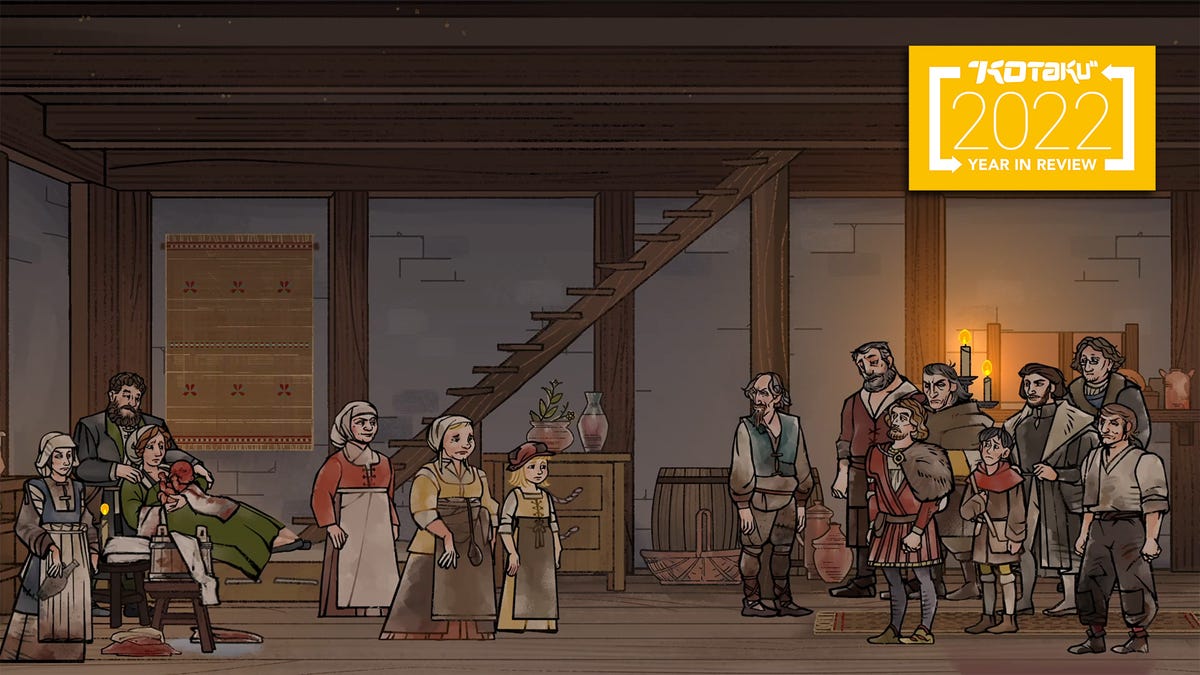
2022 brought us a number of rich narratives in games. While heavy hitters like God of War: Ragnarok, Elden Ring, or Destiny 2’s The Witch Queen expansion are likely to have their praises sung the loudest, there were also games like Obsidians’ Pentiment that are equally deserving of our attention.
Pentiment is a work of interactive historical fiction and though the game might be the most rewarding for history wonks, its historical grounding and well-written NPCs (who never feel like they exist just to spout history lessons) make it one of this year’s best storytelling accomplishments. We sat down with Josh Sawyer, Fallout: New Vegas, Pillars of Eternity, and Pentiment’s director, to chat about how the team wove history and narrative so seamlessly into its characters.
Pentiment is a murder mystery set in the late 16th century. The historical premise and detective plot is appealing on its own, but it’s the natural interactions with various NPCs that keep me glued to this game. Everyone feels distinctly real, with purpose and knowledge, and serve to sketch the historical background of the fictional town of Tassing specifically, but also late medieval Europe. It is both a history lesson and a character study, and engrossing the whole way through.
Read More: This Killer Narrative Game From Obsidian Is A Must-Play
Speaking with Kotaku, director Josh Sawyer describes the process of choosing who to deliver what historical lessons as an important facet of world and character building. It wasn’t enough for Pentiment to simply make sure each character would have a justifiable reason for their knowledge. A character’s personal interests and who they are in the world is also taken into account, and that shapes, when, where, and how they tell their stories
“It’s actually been a challenge for a lot of my career, and so something over the last few games that I’ve worked on is when characters are going to essentially engage in exposition, my question usually to the writer is ‘why is this character the character to tell the story?’ Because if the answer is ‘well, we need someone to tell it,’ that’s not a good answer.”
Sawyer continues: “The [exposition] that’s being told has to mean something that’s really important to the person telling it. And I think that is probably why people feel like it feels more natural than, for example if you’re in a history class, or a social studies class, and someone’s kind of lecturing at you.”
An example Sawyer gives is Til Kreutzer, one of Pentiment’s characters who readily talks of the world’s history—particularly that of the Romans who predate this period.. But that knowledge must come from somewhere important to the character. Through the game we learn that he had been given access to the church’s library, access that he no longer has. Combined with where he works, Til becomes a natural source of worldbuilding for Tassing (establishing his history with the church) as well as the history of the region.

“[Til] works in the field. And he looks at the Roman ruins all the time. He’s a shepherd. And he’s like ‘I love books and I love the stories about the Romans’ and I think it comes across that this is something that he really cares about and is interested in. When Andreas sees the figure jump across the aqueduct, [that’s why Kreutzer says] ‘oh yeah, who knows how many Roman [spirits] are here.’”
The scene Sawyer refers to is one where the protagonist, Andreas, spies what is assumed to be a ghost near the Roman ruins (though it’s not entirely clear what it is). Til is a natural fit to provide the context and add to the spookiness of the scene, thanks to his learned knowledge and proximity to the ruins themselves. This scene, and previous conversations with Til, paint a portrait of a living history within Tassing. That history is both seen and unseen, in the ruins and stories people tell. It’s what makes the sighting of the apparition all the more spooky, even though there doesn’t appear to be anything supernatural going on in the game whatsoever.
Had Til just been a bog standard NPC who delivered lines of dialogue about ruins, and not something with a personal interest and a bit of a backstory as to how he developed that interest, this scene wouldn’t land with the same weight.
A recurring theme in Pentiment is the history of paganism in the region. While the town is thoroughly Christianized and many characters embrace that faith, old beliefs and customs are not easily forgotten. As you’re unfolding more and more of Pentiment’s story, you get a greater sense of the path that lies between different historical eras, and how that feeds into the daily lives of these people. For this, Sawyer described Ill Peter as an effective conduit for an understanding of how things were before the church.
“Ill Peter is one of the repositories of pagan knowledge within the community and he resents that the new abbot doesn’t really respect their traditions. So this is something that’s important to him. He believes it’s important to continue practicing [older traditions] and he kind of resents the abbot and is a little sour that young people don’t remember these old ways.”
Pentiment’s characters aren’t merely delivering “abstract” history lessons, Sawyer says, and that’s what makes them work so well as the primary story movers. The individual interests of each character impact your work as you investigate potential motives and unpack the sticky intersectional fabric that might have led to the murder in question. Everything is inherently tied up in historical and political connections. Chatting with just about any character is an opportunity for the game to show off the historical research that went into its development, while also providing various hints about other characters, giving Andreas what he needs to piece the murder mystery together.
But none of that would resonate, whether it’s fictional or not, if these characters didn’t have personal investments in what they’re talking about or didn’t feel like real people. Sawyer’s extensive work to establish them as believable figures is what makes Pentiment’s characters so fascinating.

More than anything else in Pentiment, I enjoyed my time with these characters, learning about their lives, and sharing meals with them. What they have to say about the world, both the broader one that exists outside of the bounds of Tassing and their daily lives as well, is what pulled me into the murder mystery. No one felt like a generic NPC townsperson tasked with walking around in circles delivering history lessons.
“These are all stories that are important to these individual people” Sawyer said, “and I try to make sure that the writers communicate the connection of the story to the person, not just the story itself. Because if you don’t communicate both, it’s gonna not feel good.”
Pentiment is a unique game. One that may not be for everyone. But in 2022, it stands as a stellar example of how intentional decisions over who tells what story satisfies the utility of teaching the player about the world while also presenting characters who have an investment in the world around them. That effect is contagious, leading to you the player in turn caring about the world of the game and the time you spend in it.







Leave feedback about this